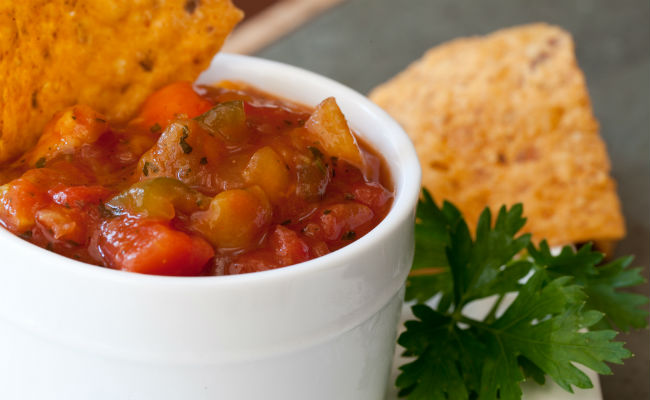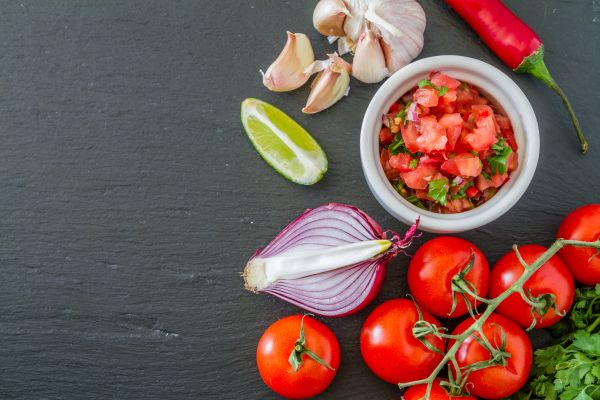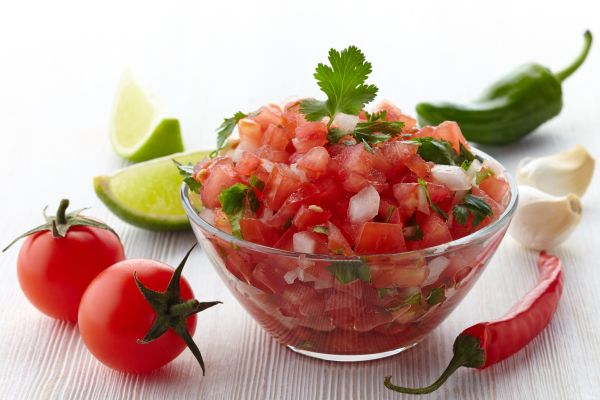
I haven’t bought a bag of chips and a jar of salsa in weeks. Nor have I picked up any of the individual ingredients to make my own salsa, which I learned how to do with my friends and their families growing up in the southeastern tip of Houston, Texas.
“Wait a minute,” you might be thinking. “If you’re going to write about how incredibly awesome salsa is, then why the hell are you opening with the ‘I don’t buy salsa’ line?”
Let me explain: Whenever I would buy chips and salsa (or salsa ingredients), my intention was to eat them with some degree of moderation. Chips and salsa are, after all, a snack food. My original plan was always to cook a nice soup, bake something in the oven, or prepare a stove-top dish of some kind. The chips and salsa were for munching, and I wasn’t going to jeopardize my meal plans by…
Screw that. I finished them all. Always. Every time. Soup can go to hell.
This happened to me, over and over, because salsa tastes really, really good. According to a 2014 projection, 71.69 million people in the U.S. eat salsa during any given week. Even without chips, this traditional Mexican culinary masterpiece can be added to just about anything — breakfast foods, vegetable dishes (especially potatoes), and yes, even pizza.
Not all salsas are created equal (or correctly, for that matter), and to better understand what goes into a good one, you have to know a thing or two about the condiment’s rich history. A history that, as it turns out, predates the arrival of the first Spanish settlers in North, South, and Central America.

According to culinary historian Sophie D. Coe’s America’s First Cuisines, the act of combining chiles, tomatoes, beans and other items into a sauce or sauce-like foodstuff can be traced all the way back to the Aztecs. Per the writings of Bernardino de Sahagún, a Franciscan missionary who came to New Spain in 1529, what we now call salsa was often sold in Aztec markets during the 16th century. In a passage cited by Coe, Sahagún describes one of the seller’s offerings:
He sells foods, sauces, hot sauces, fried [food], olla-cooked, juices, sauces of juices, shredded [food] with chile, with squash seeds, with tomatoes, with smoked chile, with hot chile, with yellow chile, with mild red chile sauce, yellow chile sauce, sauce of smoked chile, heated sauce, he sells toasted beans, cooked beans, mushroom sauce, sauce of small squash, sauce of large tomatoes, sauce of ordinary tomatoes, sauce of various kinds of sour herbs, avocado sauce.
By the time the Spaniards rolled into the new world, these early salsas had been around for centuries. Sounds like they had guac down, too. When Mexico’s independence from Spain was recognized in 1836, the long since conquered and assimilated indigenous cultures were already a part of the landscape — their salsa became “Mexican.”

It didn’t take salsa long to march well beyond the borders of Mexico. In the early going, it was especially popular in the American Southwest (territories that were part of Mexico prior to the Mexican-American War). With an influx of Mexican immigrants into southwestern and western states throughout the 1900s, salsa soon became a widespread staple.
Gustavo Arellano documents this (and the rise of many other Mexican cuisines in the U.S.) in his 2012 book, Taco USA: How Mexican Food Conquered America. In a chapter dedicated wholly to salsa becoming the top-selling condiment in America, he pinpoints David Pace’s creation of Pace Picante in 1947 and Mountain Pass Canning Company’s (known now as Old El Paso) 1948 “taco sauce” as the two pivotal moments in salsa’s surging popularity. And then the ’80s happened:
The 1980s saw the exponential ascendancy of salsa in the American market, a rise so sudden that American food companies were caught off guard and forced to play catch-up… That decade saw the rise of an informed American gastronome more accepting of ethnic flavors than ever before, and willing to replicate them at home.
The health food craze of the late ’70s and early ’80s also played a role. Arellano points this out in his book, but when I confessed my tendency to eat too much of the stuff over the phone, he reminded me of salsa’s health benefits.
“Salsa’s good for you. Salsa’s way better for you than gorging on tacos or chicharones. It’s been scientifically proven that chiles and peppers are good for your digestive tract,” said Arellano. “People always ask me, ‘Won’t salsa burn a hole through your stomach?’ Nah, it’s only going to burn through the crap.”
Arellano, the son of Mexican immigrants, couldn’t contain his love of salsa during our phone conversation. He joked that he was “born out of the cradle with it,” and that all he had to do while growing up was “get a big bowl of salsa and go to town on it” whenever he wanted a snack. Obviously I could relate, not only because I regularly did this (bowl and all) up until a few weeks ago, but because salsa was one of my primary food groups as a kid.
I understand that Arellano’s health endorsement is just for salsa, not for chips, but still… it’s enough for me. My salsa fast was pointless. Life is too short to cheat ourselves. I’m going to get some right now. Maybe you should too.






